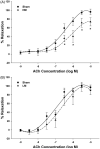Effects of acute inhalation of aerosols generated during resistance spot welding with mild-steel on pulmonary, vascular and immune responses in rats
- PMID: 25140454
- PMCID: PMC4708061
- DOI: 10.3109/08958378.2014.944287
Effects of acute inhalation of aerosols generated during resistance spot welding with mild-steel on pulmonary, vascular and immune responses in rats
Abstract
Spot welding is used in the automotive and aircraft industries, where high-speed, repetitive welding is needed to join thin sections of metal. Epoxy adhesives are applied as sealers to the metal seams. Pulmonary function abnormalities and airway irritation have been reported in spot welders, but no animal toxicology studies exist. Therefore, the goal of this study was to investigate vascular, immune and lung toxicity measures after exposure to these metal fumes in an animal model. Male Sprague-Dawley rats were exposed by inhalation to 25 mg/m³ to either mild-steel spot welding aerosols with sparking (high metal, HM) or without sparking (low metal, LM) for 4 h/d for 3, 8 and 13 d. Shams were exposed to filtered air. Bronchoalveolar lavage (BAL), lung gene expression and ex vivo BAL cell challenge were performed to assess lung toxicity. Lung resistance (R(L)) was evaluated before and after challenge with inhaled methacholine (MCh). Functional assessment of the vascular endothelium in isolated rat tail arteries and leukocyte differentiation in the spleen and lymph nodes via flow cytometry was also done. Immediately after exposure, baseline R(L) was significantly elevated in the LM spot welding aerosols, but returned to control level by 24 h postexposure. Airway reactivity to MCh was unaffected. Lung inflammation and cytotoxicity were mild and transient. Lung epithelial permeability was significantly increased after 3 and 8 d, but not after 13 d of exposure to the HM aerosol. HM aerosols also caused vascular endothelial dysfunction and increased CD4+, CD8+ and B cells in the spleen. Only LM aerosols caused increased IL-6 and MCP-1 levels compared with sham after ex vivo LPS stimulation in BAL macrophages. Acute inhalation of mild-steel spot welding fumes at occupationally relevant concentrations may act as an irritant as evidenced by the increased R(L) and result in endothelial dysfunction, but otherwise had minor effects on the lung.
Keywords: Cardiovascular; inhalation studies; particulate matter; volatile organic compounds; welding.
Figures






References
-
- Afshari A, Zeidler-Erdely PC, McKinney W, et al. Development and characterization of a resistance spot welding aerosol generator and inhalation exposure system. Inhal Toxicol. 2014 in press. - PubMed
-
- Anderson SE, Meade BJ, Butterworth LF, Munson AE. The humoral immune response of mice exposed to manual metal arc stainless steel-welding fumes. J Immunotoxicol. 2007;4:15–23. - PubMed
-
- Antonini JM, Stone S, Roberts JR, et al. Effect of short-term stainless steel welding fume inhalation exposure on lung inflammation, injury, and defense responses in rats. Toxicol Appl Pharmacol. 2007;223:234–45. - PubMed
-
- Antonini JM, Roberts JR, Stone S, et al. Short-term inhalation exposure to mild steel welding fume had no effect on lung inflammation and injury but did alter defense responses to bacteria in rats. Inhal Toxicol. 2009;21:182–92. - PubMed
-
- Antonini JM, Roberts JR, Stone S, et al. Persistence of deposited metals in the lungs after stainless steel and mild steel welding fume inhalation in rats. Arch Toxicol. 2011;85:487–98. - PubMed
Publication types
MeSH terms
Substances
Grants and funding
LinkOut - more resources
Full Text Sources
Other Literature Sources
Medical
Research Materials
Miscellaneous
